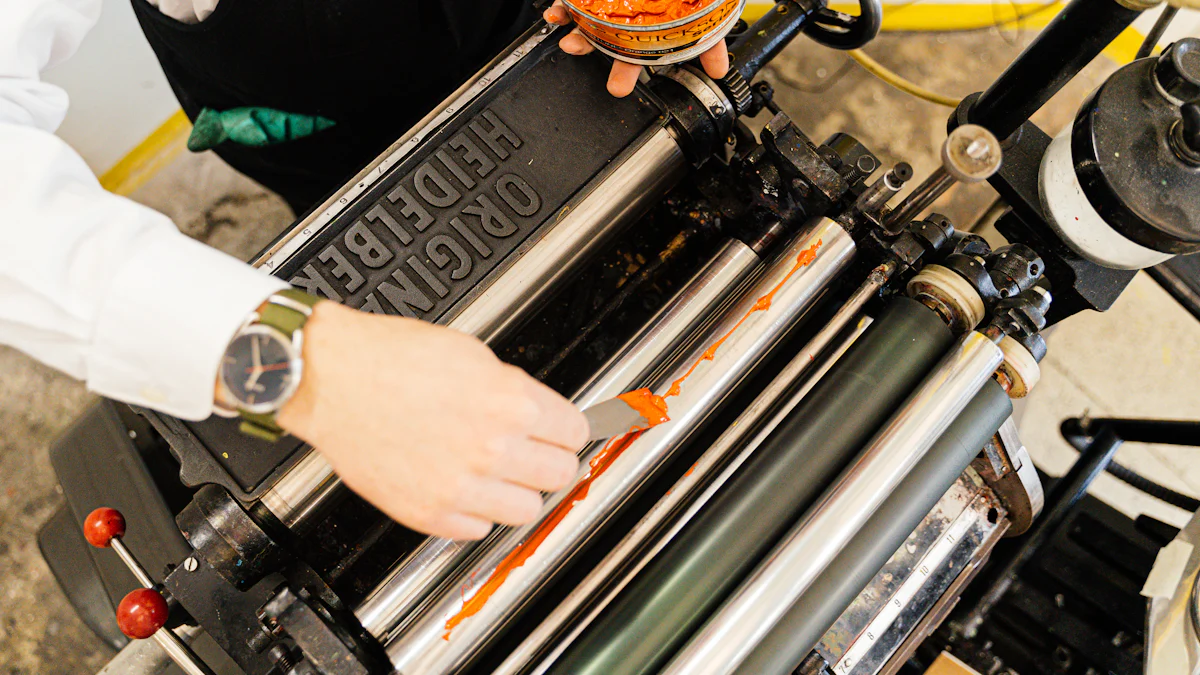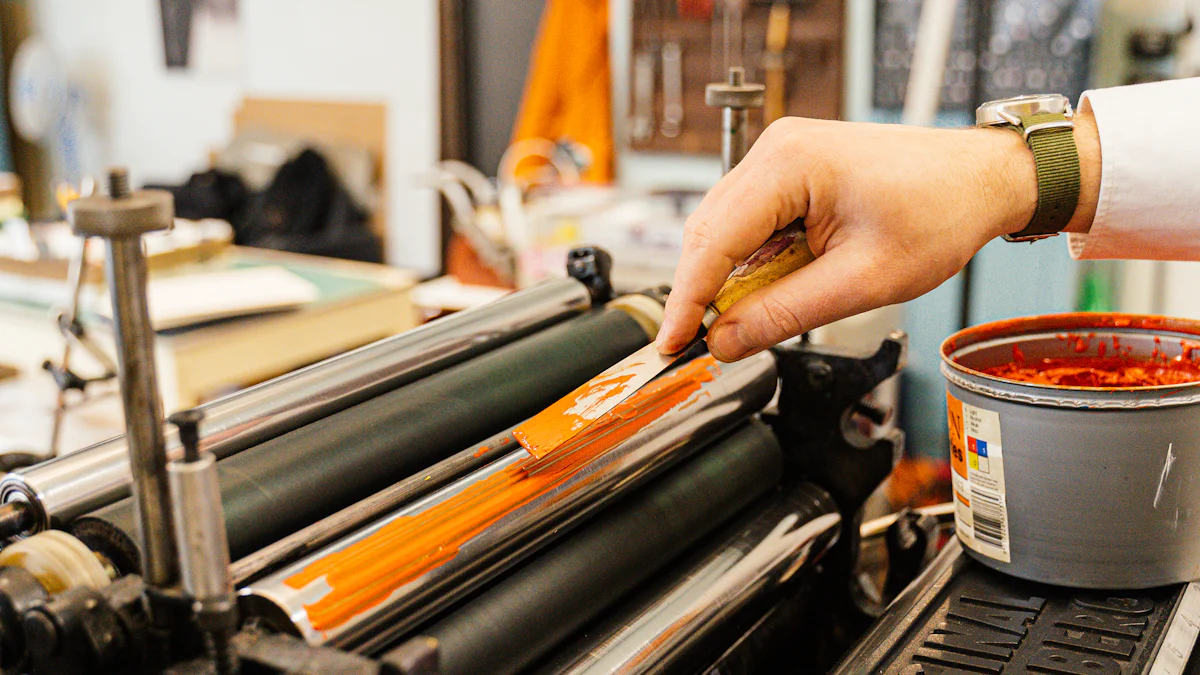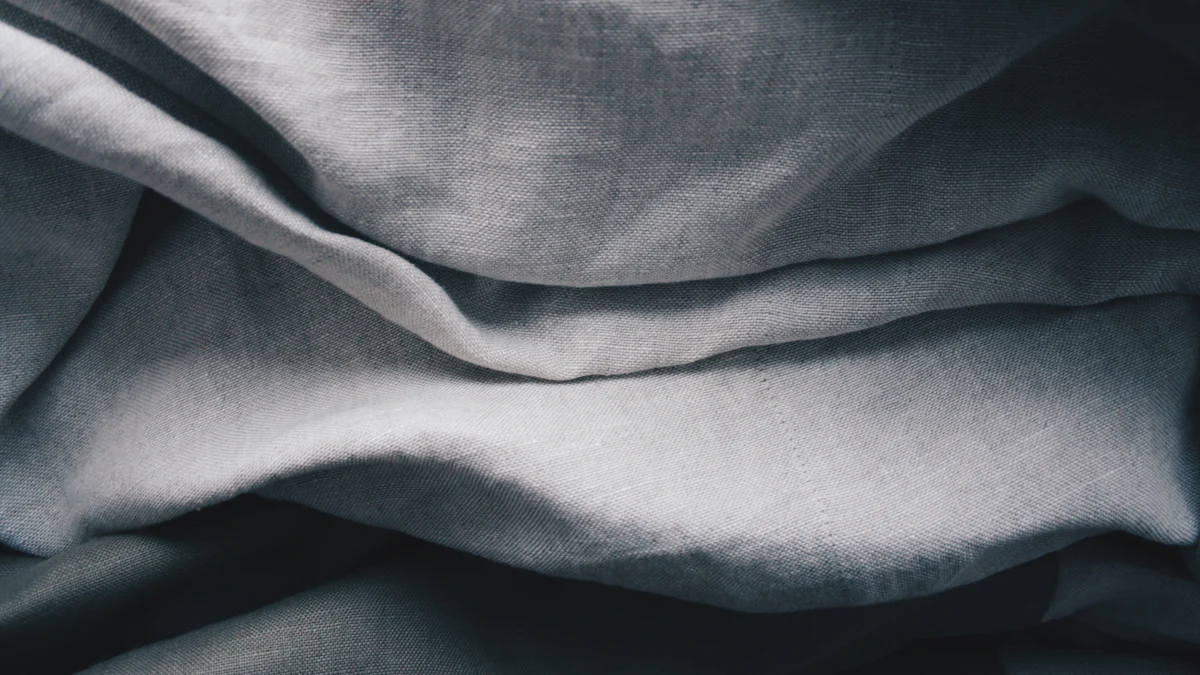
Using TPU powder in DTF printing transforms your designs into vibrant, durable prints, especially when sourced from a reliable DTF printing China manufacturer. This hot melt adhesive powder ensures that your artwork adheres seamlessly to flexible materials. You will find that TPU powder provides elasticity and durability, allowing your designs to stretch with the fabric without cracking. Its soft hand feel makes the printed area comfortable against the skin. Whether you are a professional or a DIY enthusiast, TPU powder simplifies the printing process, offering easy application and curing. With its flexibility, TPU powder is ideal for creating prints that move with the fabric.
Key Takeaways
TPU powder enhances flexibility and durability in DTF prints, making them ideal for stretchy materials like sportswear.
Achieving an even application of TPU powder is crucial; use a sifter to prevent clumps and ensure a smooth finish.
Proper curing is essential for durability; set your heat press to 320°F (160°C) and apply even pressure for 15-20 seconds.
Pre-press your fabric to remove moisture and wrinkles before transferring the design for optimal adhesion.
Conduct test prints to fine-tune your settings and ensure high-quality results tailored to your materials.
TPU powder is eco-friendly and user-friendly, making it suitable for both professional and DIY printing projects.
Regular maintenance of your printer and equipment contributes to consistent print quality and successful transfers.
Understanding TPU Powder and DTF Printing
What is TPU Powder?
Thermoplastic polyurethane, commonly known as TPU, is a versatile material used in various applications, including DTF (Direct to Film) printing. As a hot melt adhesive powder, TPU plays a crucial role in ensuring that your printed designs adhere effectively to fabrics. This powder provides elasticity and durability, allowing the printed design to stretch with the fabric without cracking. The flexibility of TPU powder makes it ideal for creating prints that move seamlessly with the material, offering a soft hand feel that is comfortable against the skin.
Basics of DTF Printing
DTF printing is a modern technique that involves printing designs onto a special film and then transferring them onto fabrics using heat and pressure. This method allows for vibrant and detailed prints, making it popular among both professionals and hobbyists. In DTF printing, you start by creating your design using digital software. You then print the design onto a DTF film using a specialized printer. The ink remains wet, allowing you to apply TPU powder evenly over the printed area. This step is crucial for achieving a durable and vibrant print. Once the powder is applied, you use a heat press to transfer the design from the film to the fabric, solidifying the TPU powder and creating a soft, flexible image.
Why TPU is Perfect for Flexible Materials
Thermoplastic polyurethane is particularly suited for flexible materials due to its unique properties. It offers excellent resilience and stretch resistance, making it less prone to cracking and deformation. This makes TPU powder an ideal choice for applications where the printed material needs to be stretchable, such as sportswear and activewear. Additionally, TPU’s ability to provide strong adhesion on fabrics like cotton and polyester ensures that your designs remain vivid and durable. Its eco-friendly nature also makes it safe for various printing needs, enhancing the overall quality and longevity of your prints.
Step-by-Step Guide to Using TPU Powder in DTF Printing

Preparing Your Design
Choosing the Right Design Software
To begin your DTF printing journey, select design software that suits your needs. Popular choices include Adobe Illustrator and CorelDRAW. These programs offer robust tools for creating intricate designs. Ensure your software supports high-resolution outputs, as this will enhance the quality of your DTF transfers. A well-prepared design is crucial for achieving vibrant and detailed prints.
Setting Up the Printer
Once your design is ready, focus on setting up your printer. Ensure your DTF printer is compatible with the film you plan to use. Check the printer settings to match the specifications of your design. Proper calibration ensures that the ink adheres correctly to the film, which is essential for a successful transfer. Regular maintenance of your printer also contributes to consistent print quality.
Printing the Design
Selecting the Film
Choosing the right film is vital for effective DTF printing. Look for films that are specifically designed for DTF applications. These films should be able to hold the ink well and withstand the heat press process. The film acts as a carrier for your design, so its quality directly impacts the final print. Ensure the film is clean and free from dust before printing.
Printing Process
With your film ready, proceed to print your design. Load the film into the printer and initiate the printing process. Ensure the ink remains wet after printing, as this is crucial for the next step. The wet ink allows for the easy and even application of DTF powder, which enhances the durability of the print. Monitor the printing process to avoid any errors or misalignments.
Applying TPU Powder
How to Apply the Powder Evenly
After printing, apply the TPU powder to the wet ink on the film. Use a sifter or a similar tool to distribute the powder evenly across the design. An even application ensures that the powder bonds well with the ink, providing elasticity and durability to the final print. This step is crucial for achieving a soft and flexible image.
Tips for Avoiding Clumps
To prevent clumps, gently shake off any excess powder from the film. Clumps can lead to uneven prints and affect the transfer process. Ensure the powder layer is thin and uniform. If necessary, use a brush to smooth out any areas where the powder appears thick. Proper application of the DTF powder is key to maintaining the quality of your DTF transfers.
Removing Excess Powder
Techniques for Efficient Removal
After applying the TPU powder, you need to remove any excess to ensure a clean and precise print. Start by gently tapping the back of the film to dislodge loose powder. This technique helps in maintaining the integrity of your design. You can also use a soft brush to sweep away any remaining powder particles. This step is crucial for achieving a smooth finish and preventing any unwanted texture on the final print.
Tools You Might Need
To effectively remove excess DTF powder, consider using a few handy tools. A soft-bristled brush works well for sweeping away powder without damaging the wet ink. A small vacuum cleaner with a gentle setting can also help in sucking up loose particles. These tools ensure that your design remains intact while preparing it for the next stage of the DTF printing process.
Curing the Design
Optimal Temperature and Time
Curing the design is a vital step in DTF printing. It involves applying heat to solidify the TPU powder, ensuring durability and flexibility. Set your heat press to the recommended temperature, usually around 320°F (160°C). Press the design for about 15-20 seconds. This duration allows the powder to melt and bond with the ink, creating a durable and flexible print that adheres well to the fabric.
Common Mistakes to Avoid
Avoid common mistakes during curing to ensure the best results. Do not rush the process by reducing the curing time, as this can lead to incomplete bonding. Ensure the heat press applies even pressure across the entire design. Uneven pressure can cause parts of the design to peel off. Regularly check your equipment to maintain consistent performance and avoid any mishaps during the curing process.
Transferring the Design to Flexible Materials
Preparing the Material
Before transferring the design, prepare the material to ensure optimal adhesion. Pre-press the fabric for a few seconds to remove moisture and wrinkles. This step enhances the interaction between the ink and the fabric, resulting in a smoother transfer. Ensure the material is clean and free from any debris that might interfere with the transfer process.
Transfer Process
With the material ready, position the film with the cured design onto the fabric. Use the heat press to apply pressure and heat, typically at the same temperature used during curing. Press for about 10-15 seconds to transfer the design onto the fabric. Carefully peel away the film while it is still warm to reveal your vibrant and durable print. This process ensures that the design adheres seamlessly to the flexible material, maintaining its elasticity and durability.
Benefits of Using TPU Powder in DTF Printing
Enhanced Flexibility and Durability
When you use TPU powder in DTF printing, you gain the advantage of enhanced flexibility and durability. TPU powder is known for its ability to stretch and move with the fabric, making it ideal for creating super soft transfers. This flexibility ensures that your prints do not crack or peel, even when applied to stretchy materials like sportswear. The durability of TPU powder means that your designs will withstand multiple washes without losing their vibrant colors or integrity. This makes TPU an excellent choice for achieving professional-quality results in your DTF transfers.
Improved Print Quality
TPU powder significantly improves the quality of your prints. It provides a smooth and even surface for the ink to adhere to, resulting in high-quality prints with sharp details and vivid colors. The elasticity of TPU allows the design to maintain its clarity and brightness over time. By using TPU powder, you ensure that your DTF prints remain vibrant and durable, offering a superior finish compared to other powders. This improvement in print quality is crucial for both professional print shops and DIY enthusiasts who seek to produce vibrant and durable prints.
Ease of Application and Curing
One of the standout benefits of TPU powder is its ease of application and curing. Applying TPU powder to your DTF film is straightforward, and it bonds well with the ink, ensuring a reliable transfer process. The curing process is also simplified, as TPU powder melts and adheres quickly under heat, allowing for efficient production of super soft transfers. This ease of use makes TPU powder a preferred choice for those looking to achieve consistent and high-quality results in their DTF printing projects. Whether you are working on a large-scale production or a small DIY project, TPU powder offers a user-friendly solution that enhances the overall efficiency of the printing process.
Common Challenges When Using TPU Powder for Flexible Materials and How to Solve Them

Problem
When using TPU powder for DTF printing on flexible materials, you might encounter several challenges. One common issue is achieving an even application of the powder. Uneven distribution can lead to clumps, which affect the quality of the print. Clumps can cause the design to appear patchy or uneven, reducing its visual appeal. Another challenge is ensuring the powder bonds properly with the ink. If the powder does not adhere well, the print may peel or crack over time. Additionally, maintaining the right temperature and pressure during the curing process can be difficult. Incorrect settings can result in incomplete bonding, leading to prints that do not last.
Solution
To overcome these challenges, follow these practical solutions:
Even Application of Powder: Use a sifter or fine mesh to distribute the TPU powder evenly over the wet ink. This tool helps prevent clumps and ensures a smooth layer. Gently shake off excess powder to maintain an even coating.
Proper Bonding: Ensure the ink remains wet before applying the powder. This wetness allows the powder to bond effectively. If necessary, adjust your printer settings to keep the ink moist longer.
Curing Process: Set your heat press to the recommended temperature and pressure. Typically, 320°F (160°C) works well for TPU powder. Apply even pressure across the entire design for about 15-20 seconds. Regularly check your equipment to ensure consistent performance.
Testing and Adjustments: Conduct test prints to fine-tune your process. Experiment with different settings to find the optimal combination for your materials and designs. Keep a record of successful settings for future reference.
By addressing these challenges with these solutions, you can achieve high-quality, durable prints on flexible materials using TPU powder.
In your journey with DTF printing, using TPU powder proves essential. You start by preparing your design and setting up your printer. Then, you print the design and apply the powder evenly. After removing excess powder, you cure the design. Finally, you transfer the design to flexible materials, ensuring a vibrant and durable finish. TPU powder enhances flexibility and durability, making your prints last longer. It also improves print quality and simplifies the application process. By mastering these steps, you ensure high-quality results every time you transfer the design.
FAQ
What is TPU powder, and why is it used in DTF printing?
TPU powder, or Thermoplastic Polyurethane powder, is a hot melt adhesive known for its flexibility and durability. In DTF (Direct to Film) printing, you use TPU powder to ensure that your designs adhere well to fabrics. Its elasticity allows printed designs to move and stretch with the fabric, making it ideal for creating vibrant, durable prints on flexible materials.
How does TPU powder enhance the quality of DTF prints?
TPU powder enhances print quality by providing a smooth surface for the ink to adhere to, resulting in sharp details and vivid colors. Its flexibility ensures that your prints do not crack or peel, even on stretchable materials like sportswear. This makes TPU powder essential for achieving professional-quality results in your DTF transfers.
Can TPU powder be used on all types of fabrics?
You can use TPU powder on a variety of fabrics, including cotton, polyester, and blends. Its strong adhesion properties make it suitable for both natural and synthetic materials. However, for optimal results, ensure the fabric is clean and pre-pressed to remove moisture and wrinkles before transferring the design.
What are the common challenges when using TPU powder, and how can I overcome them?
Common challenges include achieving an even application of the powder and ensuring proper bonding with the ink. To overcome these, use a sifter for even distribution and ensure the ink remains wet before applying the powder. Set your heat press to the recommended temperature and pressure to ensure complete bonding during the curing process.
How do I apply TPU powder evenly to my DTF prints?
To apply TPU powder evenly, use a sifter or fine mesh to distribute the powder over the wet ink. Gently shake off excess powder to maintain an even coating. This technique prevents clumps and ensures a smooth layer, which is crucial for achieving a soft and flexible image.
What tools do I need for removing excess TPU powder?
For removing excess TPU powder, you might need a soft-bristled brush or a small vacuum cleaner with a gentle setting. These tools help sweep away loose particles without damaging the wet ink, ensuring a clean and precise print.
How do I ensure the durability of my DTF prints using TPU powder?
To ensure durability, follow the recommended curing process by setting your heat press to around 320°F (160°C) and applying even pressure for 15-20 seconds. This allows the TPU powder to melt and bond with the ink, creating a durable print that adheres well to the fabric.
Is TPU powder eco-friendly?
Yes, TPU powder is considered eco-friendly. It is safe for various printing needs and enhances the overall quality and longevity of your prints. Its eco-friendly nature makes it a preferred choice for sustainable printing practices.
Can I use TPU powder for DIY projects?
Absolutely! TPU powder is user-friendly and simplifies the DTF printing process, making it suitable for both professional print shops and DIY enthusiasts. Its ease of application and curing allows you to achieve consistent and high-quality results, whether you’re working on a large-scale production or a small DIY project.
What makes TPU powder different from other DTF powders like PES?
TPU powder is great for flexible designs due to its elasticity, while PES (Polyester) powder provides a strong, rigid finish. Understanding the differences between these powders helps you choose the right one for your project, ensuring high-quality results tailored to your specific needs.
